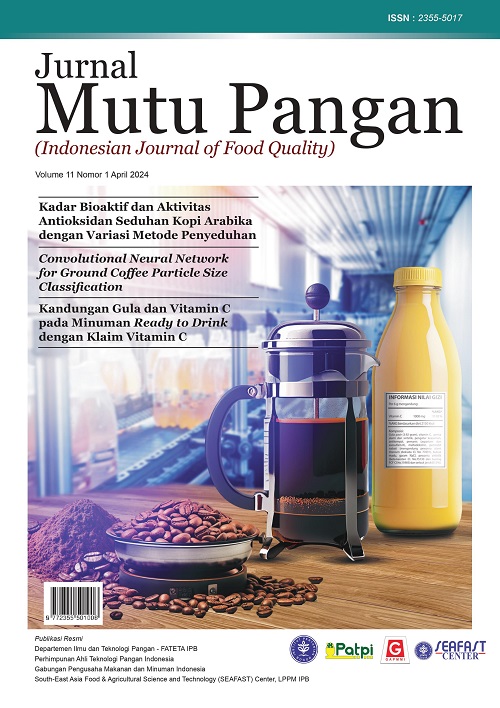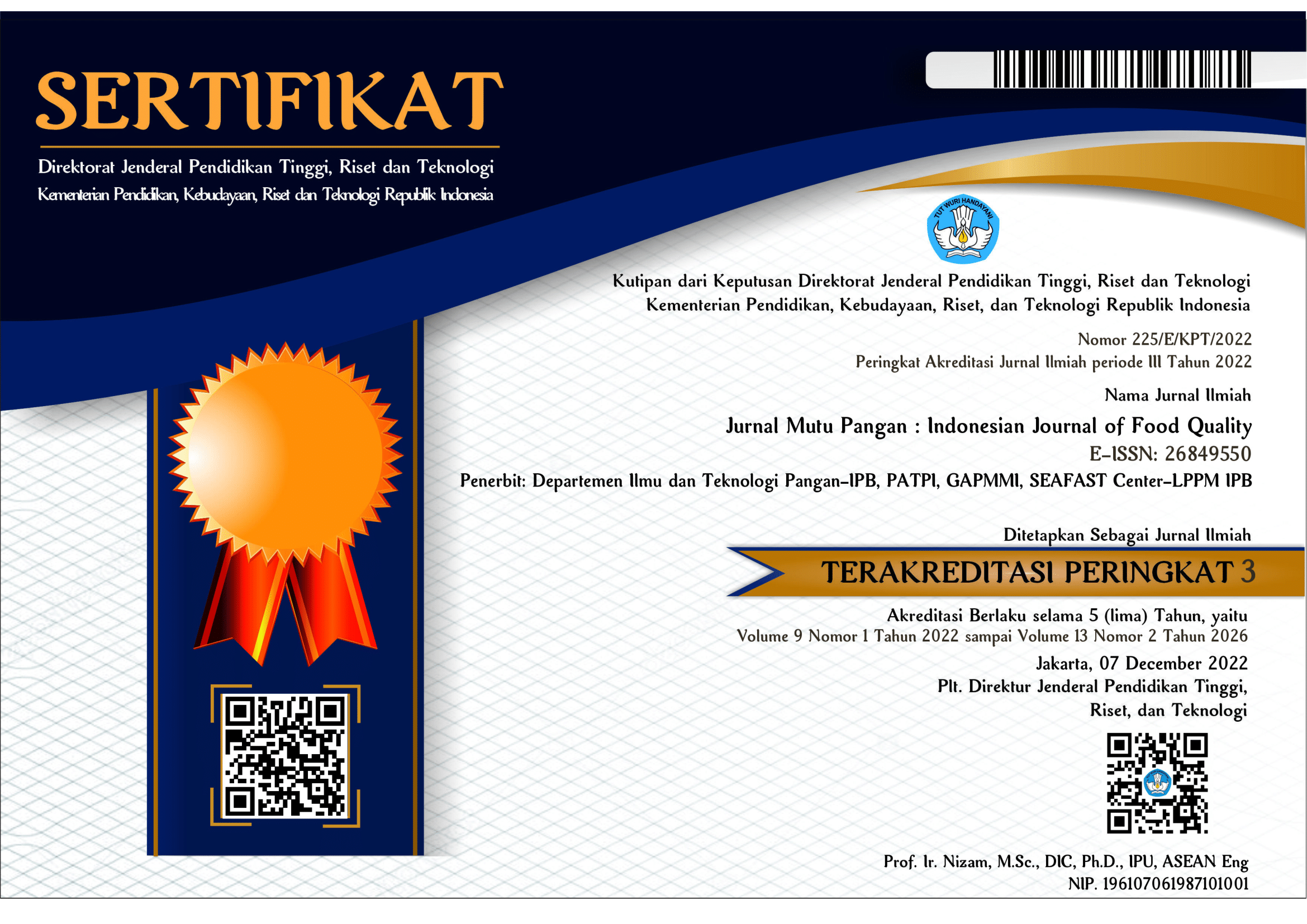Kadar Bioaktif dan Aktivitas Antioksidan Seduhan Kopi Arabika dengan Variasi Metode Penyeduhan
Abstract
Coffee contains abundant bioactive compounds related to health, among which are phenolic acids and diterpenes. This study aimed to investigate phenolic acids and diterpenes content in Arabica Gayo coffee, and its in-vitro antioxidant activities due to different brewing methods. The manual brewing methods used were tubruk (steeping), V60 drip, and hanging drip bag. The analysis conducted was determination of phenolic acid content as chlorogenic acid isomers (as 3-caffeoylquinic acid (3-CQA), 4-caffeoylquinic acid (4-CQA), and 5-caffeoylquinic acid (5-CQA)), diterpenes content (as cafestol and kahweol), and antioxidant activity using DPPH and FRAP method. The result showed that tubruk brew had 3-CQA, 4-CQA, and 5-CQA content of 0.38, 0.45, and 1.11 mg/mL, respectively, while V60 brew contained 0.39, 0.45, and 1.18 mg/mL, respectively. They were significantly higher than those in the drip bag, 0.25, 0.33, and 0.85 mg/mL, respectively. Cafestol and kahweol content in tubruk were significantly higher, reaching 3.03 and 7.86 mg/L consecutively, as in V60 were 0.40 and 1.02 mg/L and in drip bag were 0.46 and 0.85 mg/L. DPPH result displayed no significant difference per sample volume (918.45-921.17 mg ascorbic acid equivalent/L). FRAP result showed tubruk brew has the highest activity with 635.12 mg gallic acid equivalent/L, compared to V60 and drip bag brew at 560.91 and 551.10 mg gallic acid equivalent/L, consecutively. The results revealed that brewing methods affect the bioactive content of the final brew, in this research were phenolic acids and diterpenes. Various methods may differ in the variety and amount of other extracted bioactive compounds, so which affects the antioxidant activities of coffee brew.
Downloads
References
Angeloni G, Guerrini L, Masella P, Bellumori M, Daluiso S, Parenti A, Innocenti M. 2019. What kind of coffee do you drink? an investigation on effects of eight different extraction methods. Food Res Int 116 (2019): 1327–1335. DOI: 10.1016/j.foodres.2018.10.022.
Benzie IFF, Strain JJ. 1996. The ferric reducing ability of plasma (FRAP) as a measure of “antioxidant power”: the FRAP assay. Anal Biochem 239(1): 70–76. DOI: 10.1006/abio.1996.0292.
Daneschvar HL, Smetana GW, Brindamour L, Bain PA, Mukamal KJ. 2021. Impact of coffee consumption on physiological markers of cardiovascular risk: a systematic review. Am J Med 134(5): 626-636.e2. DOI: 10.1016/j.amjmed.2020.09.036.
de Carvalho Pires F, Pereira RGFA, Baqueta MR, Valderrama P, da Rocha RA. 2021. Near-infrared spectroscopy and multivariate calibration as an alternative to the agtron to predict roasting degrees in coffee beans and ground coffees. Food Chem 365(2021): 130471. DOI: 10.1016/j.foodchem.2021.130471.
Derossi A, Ricci I, Caporizzi R, Fiore A, Severini C. 2018. How grinding level and brewing method (Espresso, American, Turkish) could affect the antioxidant activity and bioactive compounds in a coffee cup. J Sci Food Agric 98(8): 3198–3207. DOI: 10.1002/jsfa.8826.
Dias RCE, de Faria-Machado AF, Mercadante AZ, Bragagnolo N, de Toledo Benassi M. 2014. Roasting process affects the profile of diterpenes in coffee. Eur Food Res Technol 239(2014): 961–970. DOI: 10.1007/s00217-014-2293-x.
Farah A, de Paula Lima J. 2019. Consumption of chloro-genic acids through coffee and health implications. Beverages 5(1): 1–29. DOI: 10.3390/beverages5010 011.
Farias-Pereira R, Park C-S, Park Y. 2019. Mechanisms of action of coffee bioactive components on lipid metabolism. Food Sci Biotechnol 28(2019): 1287-1296. DOI: 10.1007/s10068-019-00662-0.
Górecki M, Hallmann E. 2020. The antioxidant content of coffee and its in vitro activity as an effect of its production method and roasting and brewing time. Antioxidants 9(4): 308. DOI: 10.3390/antiox9040308.
Herawati D, Giriwono PE, Dewi FNA, Kashiwagi T, Andarwulan N. 2018. Critical roasting level deter-mines bioactive content and antioxidant activity of robusta coffee beans. Food Sci Biotechnol 28(2019): 7–14. DOI: 10.1007/s10068-018-0442-x.
Kaur M, Tyagi S, Kundu N. 2018. Effect of brewing methods and time on secondary metabolites, total flavonoid and phenolic content of green and roasted coffee coffea arabica, coffea canephora and mon-sooned malabar. European J Med Plants 23(1): 1–16. DOI: 10.9734/EJMP/2018/40565.
[Kementan RI] Kementerian Pertanian Republik Indonesia. 2017. Outlook kopi 2017. Pusat Data dan Sistem Informasi Pertanian, Jakarta.
Lee M, McGeer EG, McGeer PL. 2016. Quercetin, not caffeine, is a major neuroprotective component in coffee. Neurobiol Aging 46(2016): 113–123. DOI: 10.1016/j.neurobiolaging.2016.06.015.
Liang N, Kitts DD. 2014. Antioxidant property of coffee components: Assessment of methods that define mechanisms of action. Molecules 19(11): 19180–19208. DOI: 10.3390/molecules191119180.
Liang N, Xue W, Kennepohl P, Kitts DD. 2016. Interactions between major chlorogenic acid isomers and chemical changes in coffee brew that affect antioxidant activities. Food Chem 213(2016): 251–259. DOI: 10.1016/j.foodchem.2016.06.041.
Lo Scalzo R. 2008. Organic acids influence on DPPH scavenging by ascorbic acid. Food Chem 107(1): 40-43. DOI: 10.1016/j.foodchem.2007.07.070.
Lu M-Y, Lai JC-Y, Chen S-J. 2023. Influence of sex differences on serum lipid profiles among habitual coffee drinkers: Evidence from 23,072 Taiwan biobank participants. Nutrients 15(11): 2576. DOI: 10.3390/nu15112576.
Ludwig I, Clifford M, Lean MEJ, Ashihara H, Crozier A. 2014. Coffee: Biochemistry and potential impact on health. Food Funct 5(8): 1695–1717. DOI: 10.1039/C4FO00042K.
Mellbye FB, Jeppesen PB, Shokouh P, Laustsen C, Hermansen K, Gregersen S. 2017. Cafestol, a bioactive substance in coffee, has antidiabetic properties in KKAy mice. J Nat Prod 80(8): 2353–2359. DOI: 10.1021/acs.jnatprod.7b00395.
Merecz A, Marusińska A, Karwowski BT. 2018. The content of biologically active substances and antioxidant activity in coffee depending on brewing method. Pol J Natur Sci 33(2): 267–284.
Miłek M, Młodecki Ł, Dżugan M. 2021. Caffeine content and antioxidant activity of various brews of specialty grade coffee. ACTA Sci Pol Technol Aliment 20(2): 179–188. DOI: 10.17306/J.AFS.2021.0890.
Moeenfard M, Rocha L, Alves A. 2014. Quantification of caffeoylquinic acids in coffee brews by HPLC-DAD. J Anal Methods Chem 2014: 965353. DOI: 10.1155/2014/965353.
Moeenfard M, Silva JA, Borges N, Santos A, Alves A. 2015. Quantification of diterpenes and their palmitate esters in coffee brews by HPLC-DAD. Int J Food Prop 18(10): 2284–2299. DOI: 10.1080/10942912.2014.933351.
Moeenfard M, Erny GL, Alves A. 2016. Variability of some diterpene esters in coffee beverages as influenced by brewing procedures. J Food Sci Technol 53(2016): 3916–3927. DOI: 10.1007/s13197-016-2378-6.
Muzaifa M, Hasni D. 2016. Exploration study of gayo specialty coffee (Coffea arabica L.): Chemical compounds, sensory profile, and physical appearance. Pakistan J Nutr 15(5): 486–491. DOI: 10.3923/pjn.2016.486.491.
Novaes FJM, Bayan FC, de Aquino Neto FR, Rezende CM. 2019. The occurrence of cafestol and kahweol diterpenes in different coffee brews. Coffee Sci 14(2): 265–280. DOI: 10.25186/cs.v14i2.1571.
Ren Y, Wang C, Xu J, Wang S. 2019. Cafestol and kahweol : A review on their bioactivities and pharmacological properties. Int J Mol Sci 20(17): 4238. DOI: 10.3390/ijms20174238.
Rendón MY, do Santos Scholz MB, Bragagnolo N. 2017. Is cafestol retained on the paper filter in the preparation of filter coffee? Food Res Int 100: 798–803. DOI: 10.1016/j.foodres.2017.08.013.
[SCAA] Specialty Coffee Association of America. 2015. SCAA Standard: Golden Cup. https://www.scaa.org/PDF/resources/golden-cup-standard.pdf [26 Ok-tober 2020].
Schievano E, Finotello C, De Angelis E, Mammi S, Navarini L. 2014. Rapid authentication of coffee blends and quantification of 16-O-methylcafestol in roasted coffee beans by nuclear magnetic resonance. J Agric Food Chem 62(51): 12309–12314. DOI: 10.1021/jf505013d.
Skroza D, Šimat V, Vrdoljak L, Jolić N, Skelin A, Čagalj M, Frleta R, Mekinić IG. 2022. Investigation of antioxidant synergisms and antagonisms among phenolic acids in the model matrices using FRAP and ORAC methods. Antioxidants 11(9): 1784. DOI: 10.3390/antiox11091784.
Vicente SJV, Queiroz YS, Gotlieb SLD, da Silva Torres EAF. 2014. Stability of phenolic compounds and antioxidant capacity of regular and decaffeinated coffees. Braz Arch Biol Technol 57(1): 110–118. DOI: 10.1590/S1516-89132014000100016.
Vignoli JA, Bassoli DG, Benassi MT. 2011. Antioxidant activity, polyphenols, caffeine and melanoidins in soluble coffee: The influence of processing conditions and raw material. Food Chem 124(3): 863–868. DOI: 10.1016/j.foodchem.2010.07.008.
Vignoli JA, Viegas MC, Bassoli DG, de Toledo Benassi M. 2014. Roasting process affects differently the bioactive compounds and the antioxidant activity of arabica and robusta coffees. Food Res Int 61(2014): 279–285. DOI: 10.1016/j.foodres.2013.06.006.
Zhang C, Linforth R, Fisk ID. 2012. Cafestol extraction yield from different coffee brew mechanisms. Food Res Int 49(1): 27–31. DOI: 10.1016/j.foodres.2012.06.032.

















